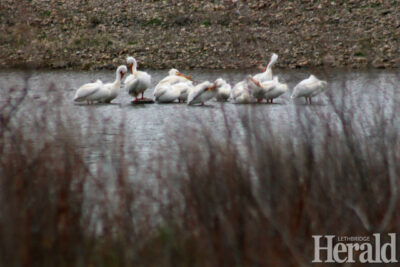Province in Stage 4 of drought response plan
By Lethbridge Herald on May 2, 2024.
 Pelicans are seen congregating on the Oldman River just downstream of the weir near the water treatment plant. The province is in Stage 4 of its drought response plan.
Herald photo by Al Beeber
Pelicans are seen congregating on the Oldman River just downstream of the weir near the water treatment plant. The province is in Stage 4 of its drought response plan.
Herald photo by Al BeeberAl Beeber – LETHBRIDGE HERALD – abeeber@lethbridgeherald.com
Alberta is in Stage 4 of its drought response plan and the government is working to employ all existing regulatory and non-regulatory tools with major water users.
The province said on Thursday in a news release this means “creating water shortage response plans, fast-tracking temporary diversion licenses to allow water to be temporarily diverted from new sources, and the landmark water-sharing agreements announced on April 19, along with other steps being implemented across southern Alberta.”
Under the plan, the province would only declare an emergency – Stage 5 – only as a last resort.
Three triggers that would prompt the declaration of an emergency are, says the province:
• If there is not sufficient water available for the priority uses. Human health and safety is the top priority, followed closely by ensuring sufficient water supplies for critical infrastructure, livestock welfare and critical environmental needs.
• If there is increasing distress from local authorities, or if local authorities are unable to respond to issues caused by drought. For example, if a state of local emergency is declared or if the Provincial Emergency Coordination Centre is activated at level 3 or higher.
• If Alberta’s water management system becomes so overwhelmed that staff cannot process or implement regulatory measures in a timely manner, impeding the drought response.
The province says the triggers will be closely watched with each situation being considered on a case-by-case basis to determine if or when an emergency declaration needs to be made.
The drought plan covers numerous matters including water-sharing agreements, conservation plans, prioritizing water and declaring emergencies.
The government says Alberta has never declared an emergency under the Water Act but in the event of one, it will take steps – working with users – to manage water in the emergency area.
The province says the response plan will be updated as the drought situation changes or if new actions could improve response to an emergency.
In Alberta, there are currently 51 water shortage advisories in place.
Minister of Environment and Protected Areas Rebecca Shultz said in the release spring has brought much-needed moisture to the province and forecasts calling for increased precipitation are cause for optimism but “we must remain prepared for drought now and into the future. Alberta’s drought response plan is foundational to that work and will help our province respond to all levels of drought for years to come.”
Objectives of the plan are protecting the health and safety of Albertans during a drought, minimizing impacts of drought on communities the economy and environment and implementing a pro-active risk-based approach to rapidly assess, prepare for and respond to droughts. It’s also intended to ensure responses to drought conditions “are agile and adjusted in real time as information changes.
Lastly, the plan is intended to enable residents to take action to conserve water and work together on conservation.
The five stages include:
• Stage 1: Monitoring and observation
Water availability trend is a concern.
• Stage 2: Active management
Droughts are predicted to occur.
• Stage 3: Priority call and/or risk to interprovincial apportionment
Assessment and administration of priority. Assessment and enhanced management of interprovincial apportionment.
• Stage 4: Significant water shortage in multiple Water Management Areas
Many water users challenged to access water. Significant basin or provincial scale drought conditions.
• Stage 5: Urgent and critical escalation of drought conditions
Emergency measures need to protect human health and public safety, critical infrastructure, livestock welfare and critical environmental needs.
Human health and safety is the top priority of the province in a water emergency followed by ensuring sufficient supplies for critical infrastructure, livestock welfare and critical environment needs, says the province.
Those priorities specifically include drinking water, potable water for cleaning, bathing and cooking, water for healthcare facilities and the maintenance of adequate pressure in municipal distribution and wastewater collection systems.
Infrastructure priorities include powerplant operations that are essential to maintain core service levels and the stability of the electricity grid. Emergency services are also a priority.
31-30





One would wonder if Stage 4 drought response would include certain farming operations running their pivot irrigation already. Water for these pivots are supposedly accessed by underground pipelines directly from the Oldman River. Are huge farming dugouts/reservoirs being filled from the local creeks and rivers right now? Is this being supervised? Or is it a free-for-all. We have seen huge multiple pivot development in this area. Even for a small 1 million gallon dugout, a single running pivot can drain it in about 8 hours, or less. It may be a very interesting summer.